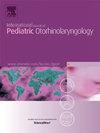NOG变异患儿的基因型和临床表型:来自韩国某三级中心的中耳手术结果。
IF 1.2
4区 医学
Q3 OTORHINOLARYNGOLOGY
International journal of pediatric otorhinolaryngology
Pub Date : 2025-02-01
DOI:10.1016/j.ijporl.2025.112230
引用次数: 0
摘要
目的:虽然NOG变异与先天性镫骨固定和传导性听力损失(CHL)有关,但对中耳手术结果和伴随的内耳异常的特征知之甚少。我们探讨了NOG变异患者的听觉表型,重点关注中耳手术的结果。方法:本研究纳入了来自5个无亲缘关系的韩国NOG变异家族的11例患者。基因组研究采用全外显子组测序和全基因组测序。分析了临床表型,包括术前和术后听力学特征、放射学异常和其他合并症。结果:基因检测的平均年龄为8.2岁(范围0-13岁)。两个先前报道的NOG变体(c.509C . > . T:p。发现了Pro170Leu和c.252dup:p.Glu85ArgfsTer97)以及三个新的NOG变体,包括c.187G > T: p.Glu63Ter和两个位于17q22.2区域的隐性大缺失。所有患者均表现为非进展性CHL。内耳异常记录在两个病人,变异如耳蜗和前庭发育不良。本研究中,4例患者7耳行镫骨切开术,气骨间隙明显减小,为10.18±1.48 dB (P = 0.016),且持续改善。相反,携带与中耳手术预后不良相关的p.Pro170Leu变异的患者被排除在手术考虑之外。结论:我们扩大了与NOG变异相关的基因型和听觉表型谱。手术干预CHL潜在的NOG变异可获得良好的结果。然而,临床医生应该考虑到某些NOG变异的潜在预后不良。总的来说,识别NOG变异可以指导改善CHL的治疗策略。本文章由计算机程序翻译,如有差异,请以英文原文为准。
Genotypes and clinical phenotypes of pediatric patients with NOG variants: Middle ear surgical outcomes from a Tertiary Center in South Korea
Objective
Although NOG variants are linked to congenital stapes fixation and conductive hearing loss (CHL), little is known about middle ear surgery outcomes and the characteristics of accompanying inner ear anomalies. We explored auditory phenotypes in patients with NOG variants, with a focus on the outcomes of middle ear surgery.
Methods
This study included 11 patients from five unrelated Korean families harboring NOG variants. Genomic investigations were conducted using whole-exome sequencing and whole-genome sequencing. The clinical phenotypes, including pre- and postoperative audiological profiles, radiological abnormalities, and other comorbidities, were analyzed.
Results
The average age at genetic testing was 8.2 years (range, 0–13 years). Two previously reported NOG variants (c.509C > T:p.Pro170Leu and c.252dup:p.Glu85ArgfsTer97) and three novel NOG variants, including the c.187G > T: p.Glu63Ter and two cryptic large deletion within the 17q22.2 region, were identified. All patients exhibited non-progressive CHL. Inner ear anomalies were documented in two patients, with variations such as cochlea and vestibular dysplasia. In this study, seven ears of four patients underwent stapedotomy, resulting in a significantly reduced air-bone gap of 10.18 ± 1.48 dB (P = 0.016), with sustained improvement. Conversely, patients carrying p.Pro170Leu variant, which is associated with poor outcomes for middle ear surgery, were excluded from surgical consideration.
Conclusion
We expanded the spectrum of genotypes and auditory phenotypes associated with NOG variants. Surgical intervention for CHL underlying NOG variants elicits favorable outcomes. However, clinicians should consider the potential for poor prognosis in certain NOG variants. Collectively, identifying NOG variants could guide the treatment strategies to improve CHL.
求助全文
通过发布文献求助,成功后即可免费获取论文全文。
去求助
来源期刊
CiteScore
3.20
自引率
6.70%
发文量
276
审稿时长
62 days
期刊介绍:
The purpose of the International Journal of Pediatric Otorhinolaryngology is to concentrate and disseminate information concerning prevention, cure and care of otorhinolaryngological disorders in infants and children due to developmental, degenerative, infectious, neoplastic, traumatic, social, psychiatric and economic causes. The Journal provides a medium for clinical and basic contributions in all of the areas of pediatric otorhinolaryngology. This includes medical and surgical otology, bronchoesophagology, laryngology, rhinology, diseases of the head and neck, and disorders of communication, including voice, speech and language disorders.

 求助内容:
求助内容: 应助结果提醒方式:
应助结果提醒方式:


